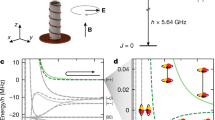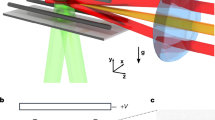Abstract
Atomic physics was revolutionized by the development of forced evaporative cooling, which led directly to the observation of Bose–Einstein condensation1,2, quantum-degenerate Fermi gases3 and ultracold optical lattice simulations of condensed-matter phenomena4. More recently, substantial progress has been made in the production of cold molecular gases5. Their permanent electric dipole moment is expected to generate systems with varied and controllable phases6,7,8, dynamics9,10,11 and chemistry12,13,14. However, although advances have been made15 in both direct cooling and cold-association techniques, evaporative cooling has not been achieved so far. This is due to unfavourable ratios of elastic to inelastic scattering13 and impractically slow thermalization rates in the available trapped species. Here we report the observation of microwave-forced evaporative cooling of neutral hydroxyl (OH•) molecules loaded from a Stark-decelerated beam into an extremely high-gradient magnetic quadrupole trap. We demonstrate cooling by at least one order of magnitude in temperature, and a corresponding increase in phase-space density by three orders of magnitude, limited only by the low-temperature sensitivity of our spectroscopic thermometry technique. With evaporative cooling and a sufficiently large initial population, much colder temperatures are possible; even a quantum-degenerate gas of this dipolar radical (or anything else it can sympathetically cool) may be within reach.
This is a preview of subscription content, access via your institution
Access options
Subscribe to this journal
Receive 51 print issues and online access
$199.00 per year
only $3.90 per issue
Buy this article
- Purchase on Springer Link
- Instant access to full article PDF
Prices may be subject to local taxes which are calculated during checkout




Similar content being viewed by others
References
Anderson, M. H., Ensher, J. R., Matthews, M. R., Wieman, C. E. & Cornell, E. A. Observation of Bose-Einstein condensation in a dilute atomic vapor. Science 269, 198–201 (1995)
Davis, K. B. et al. Bose-Einstein condensation in a gas of sodium atoms. Phys. Rev. Lett. 75, 3969–3973 (1995)
DeMarco, B. & Jin, D. S. Onset of Fermi degeneracy in a trapped atomic gas. Science 285, 1703–1706 (1999)
Bakr, W. S. et al. Probing the superfluid-to-Mott insulator transition at the single-atom level. Science 329, 547–550 (2010)
Ni, K.-K. et al. A high phase-space-density gas of polar molecules. Science 322, 231–235 (2008)
Pupillo, G. et al. Cold atoms and molecules in self-assembled dipolar lattices. Phys. Rev. Lett. 100, 050402 (2008)
Baranov, M. A., Micheli, A., Ronen, S. & Zoller, P. Bilayer superfluidity of fermionic polar molecules: many-body effects. Phys. Rev. A 83, 043602 (2011)
Levinsen, J., Cooper, N. R. & Shlyapnikov, G. V. Topological p x +ip y superfluid phase of fermionic polar molecules. Phys. Rev. A 84, 013603 (2011)
Barnett, R., Petrov, D., Lukin, M. & Demler, E. Quantum magnetism with multicomponent dipolar molecules in an optical lattice. Phys. Rev. Lett. 96, 190401 (2006)
Büchler, H. P. et al. Strongly correlated 2D quantum phases with cold polar molecules: controlling the shape of the interaction potential. Phys. Rev. Lett. 98, 060404 (2007)
Gorshkov, A. V. et al. Tunable superfluidity and quantum magnetism with ultracold polar molecules. Phys. Rev. Lett. 107, 115301 (2011)
Ospelkaus, S. et al. Quantum-state controlled chemical reactions of ultracold potassium-rubidium molecules. Science 327, 853–857 (2010)
Ni, K.-K. et al. Dipolar collisions of polar molecules in the quantum regime. Nature 464, 1324–1328 (2010)
Quéméner, G. & Julienne, P. S. Ultracold molecules under control!. Chem. Rev. 112, 4949–5011 (2012)
Carr, L. D., DeMille, D., Krems, R. V. & Ye, J. Cold and ultracold molecules: science, technology and applications. N. J. Phys. 11, 055049 (2009)
Ketterle, W. & VanDruten, N. Evaporative cooling of trapped atoms. Adv. At. Mol. Opt. Phys. 37, 181–236 (1996)
Fried, D. G. et al. Bose-Einstein condensation of atomic hydrogen. Phys. Rev. Lett. 81, 3811–3814 (1998)
Doret, S. C., Connolly, C. B., Ketterle, W. & Doyle, J. M. Buffer-gas cooled Bose-Einstein condensate. Phys. Rev. Lett. 103, 103005 (2009)
Lara, M., Bohn, J. L., Potter, D. E., Soldan, P. & Hutson, J. M. Ultracold Rb–OH collisions and prospects for sympathetic cooling. Phys. Rev. Lett. 97, 183201 (2006)
Żuchowski, P. S. & Hutson, J. M. Low-energy collisions of NH3 and ND3 with ultracold Rb atoms. Phys. Rev. A 79, 062708 (2009)
Campbell, W. et al. Mechanism of collisional spin relaxation in 3Σ molecules. Phys. Rev. Lett. 102, 013003 (2009)
Parazzoli, L. P., Fitch, N. J., Żuchowski, P. S., Hutson, J. M. & Lewandowski, H. J. Large effects of electric fields on atom-molecule collisions at millikelvin temperatures. Phys. Rev. Lett. 106, 193201 (2011)
Ticknor, C. & Bohn, J. L. Influence of magnetic fields on cold collisions of polar molecules. Phys. Rev. A 71, 022709 (2005)
Janssen, L. M. C., Żuchowski, P. S., van der Avoird, A., Groenenboom, G. C. & Hutson, J. M. Cold and ultracold NH-NH collisions in magnetic fields. Phys. Rev. A 83, 022713 (2011)
Suleimanov, Y. V., Tscherbul, T. V. & Krems, R. V. Efficient method for quantum calculations of molecule-molecule scattering properties in a magnetic field. J. Chem. Phys. 137, 024103 (2012)
Manion, J. A. et al. NIST Chemical Kinetics Database. http://kinetics.nist.gov/ (NIST Standard Reference Database 17, Web version 70, Release 1.4 3, Data version 2008. 12)
Avdeenkov, A. V. & Bohn, J. L. Collisional dynamics of ultracold OH molecules in an electrostatic field. Phys. Rev. A 66, 052718 (2002)
Sawyer, B. C., Stuhl, B. K., Wang, D., Yeo, M. & Ye, J. Molecular beam collisions with a magnetically trapped target. Phys. Rev. Lett. 101, 203203 (2008)
Child, M. S. Molecular Collision Theory 76 (Dover Publications, 1996)
Derevianko, A., Johnson, W. R., Safronova, M. S. & Babb, J. F. High-precision calculations of dispersion coefficients, static dipole polarizabilities, and atom-wall interaction constants for alkali-metal atoms. Phys. Rev. Lett. 82, 3589–3592 (1999)
Lev, B. L. et al. OH hyperfine ground state: from precision measurement to molecular qubits. Phys. Rev. A 74, 061402 (2006)
Stuhl, B. K., Yeo, M., Sawyer, B. C., Hummon, M. T. & Ye, J. Microwave state transfer and adiabatic dynamics of magnetically trapped polar molecules. Phys. Rev. A 85, 033427 (2012)
Bochinski, J. R., Hudson, E. R., Lewandowski, H. J., Meijer, G. & Ye, J. Phase space manipulation of cold free radical OH molecules. Phys. Rev. Lett. 91, 243001 (2003)
Acknowledgements
We thank E. Cornell for discussions and B. Baxley for artistic contributions. We acknowledge funding from the NSF Physics Frontier Center, DOE, AFOSR (MURI), DARPA and NIST.
Author information
Authors and Affiliations
Contributions
B.K.S., M.T.H., M.Y. and J.Y. designed and participated in the experiment, and discussed and interpreted the results. B.K.S. ran the day-to-day experiment and collected all the data. G.Q. and J.L.B. constructed the theory. B.K.S. and J.Y. first outlined the manuscript, and B.K.S. and G.Q. wrote the first draft. All authors discussed the results and contributed to the preparation of the manuscript.
Corresponding author
Ethics declarations
Competing interests
The authors declare no competing financial interests.
Supplementary information
Supplementary Figure
This file contains Supplementary Figure 1. (PDF 70 kb)
Rights and permissions
About this article
Cite this article
Stuhl, B., Hummon, M., Yeo, M. et al. Evaporative cooling of the dipolar hydroxyl radical. Nature 492, 396–400 (2012). https://doi.org/10.1038/nature11718
Received:
Accepted:
Published:
Issue Date:
DOI: https://doi.org/10.1038/nature11718
This article is cited by
-
Molecular collisions: From near-cold to ultra-cold
Frontiers of Physics (2021)
-
Simultaneous Zeeman deceleration of polyatomic free radical with lithium atoms
Frontiers of Physics (2021)
-
Collisional cooling of ultracold molecules
Nature (2020)
-
Effects of conical intersections on hyperfine quenching of hydroxyl OH in collision with an ultracold Sr atom
Scientific Reports (2020)
-
Collisions between cold molecules in a superconducting magnetic trap
Nature (2019)
Comments
By submitting a comment you agree to abide by our Terms and Community Guidelines. If you find something abusive or that does not comply with our terms or guidelines please flag it as inappropriate.



